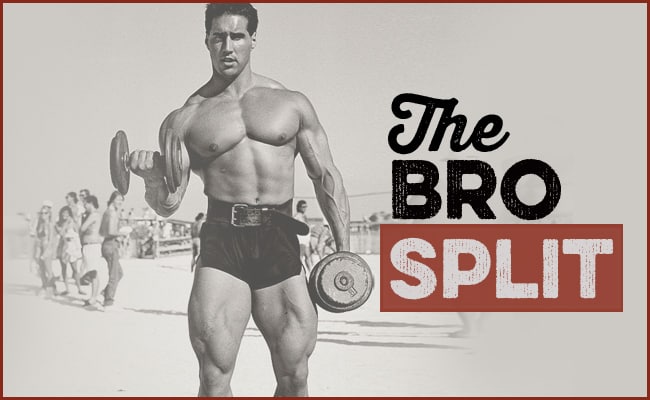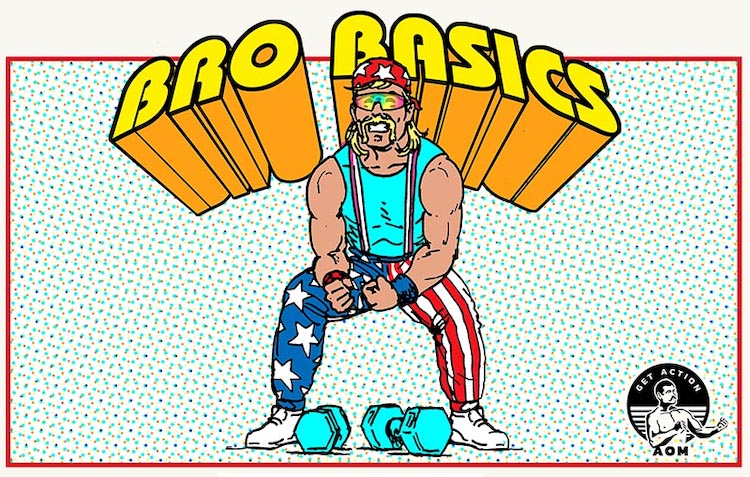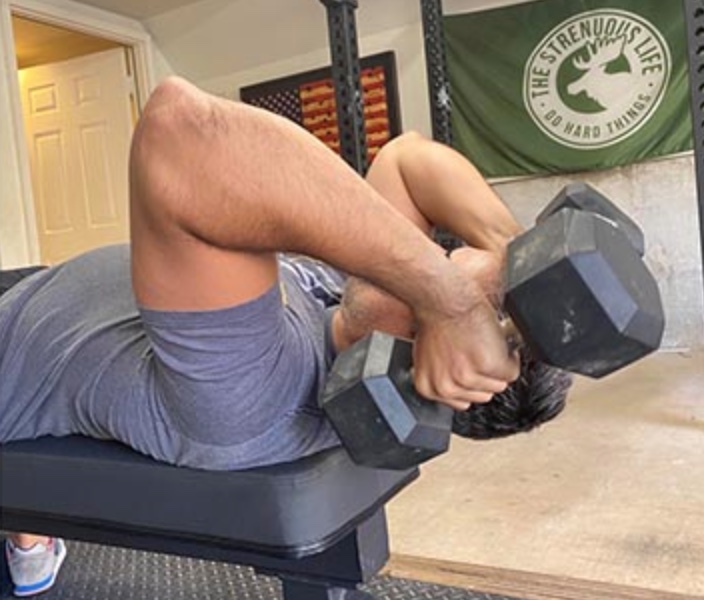
If you’ve been lifting weights for a while, you’ve likely come across programming described as “bro splits” — a training method that focuses on one muscle group per workout. You’ll also see bro splits referred to as body-split workouts.
Bro splits rose to prominence in the 1960s thanks to bodybuilders like Arnold Schwarzenegger, Franco Columbu, and Frank Zane, who used body-part-focused workouts to pack on slabs of muscle. Joe Weider helped popularize bro splits amongst average joes by publishing body-split routines in his fitness magazines. Bro splits became the de facto way most bodybuilders trained in the second half of the 20th century. It was believed that by dedicating the entirety of a workout to a single body part, you could blast it with a ton of muscle-growing stimuli while giving your muscles plenty of time to recover before you trained them again.
But starting in the 2000s, you began seeing some pushback against the bro split. The biggest criticism levied at body-split workouts is that because you trained a muscle group so infrequently (often just once a week), you didn’t stimulate the muscle enough to initiate muscle growth or increase strength. These days, the effectiveness of the bro split can be the source of lively debate on the interwebs.
So what’s the deal with bro splits? Are they effective, or are they just a relic of bodybuilding’s past? To clear up this confusion about the bro split and help you figure out if you should use it for your programming, I talked to Greg Nukols from Stronger By Science, an online publication that breaks down the scientific literature on training and nutrition.
What Exactly Is a Bro Split?
Bro splits are classically defined as programming where you focus on a single area of the body in a single workout.
A typical bro split program might look like this:
- Monday: Chest
- Tuesday: Back
- Wednesday: Shoulders
- Thursday: Legs
- Friday: Arms
- Saturday: Rest
- Sunday: Rest
Greg pointed out that there’s some debate about what constitutes a bro split. “You could conceptualize a bro split as any programming where you don’t do full-body workouts. So a classic push, pull, legs program could be a bro split because you’re not training the full body in a single workout,” he told me.
Arnold Schwarzenegger is often put out there as a bodybuilder who used bro splits to mold a mighty physique. But if you look at his programming, he didn’t focus on a single body part in his daily workouts. His split looked like this:
- Monday: Chest, Back, Abs
- Tuesday: Shoulders, Biceps, Triceps, Forearms, Abs
- Wednesday: Legs, Calves, Abs
- Thursday: Chest, Back, Abs.
- Friday: Shoulders, Biceps, Triceps, Forearms, Abs
- Saturday: Legs, Calves, Abs
- Sunday: Rest
So he was working multiple body parts in a single workout, but it’s considered by many to be a bro split.
For this article, we’ll be using the classic definition of a bro split: a program where you train a single muscle group in a single weekly workout.
Are Bro Splits Effective in Building Muscle and Strength?
As mentioned above, bro splits were popular among bodybuilders in the second half of the 20th century. However, at the start of the 21st century, there was some pushback against bro splits because research showed that training muscles more frequently than once a week could lead to more strength and muscle gains.
For example, Greg mentioned that a 2016 meta-analysis suggested that training muscles at least twice per week was more effective in driving muscle growth than training just once per week. Research has also shown that training muscles more than once a week increases strength.
So it looks like bro splits are less effective in muscle and strength growth, right?
Well, a 2020 meta-analysis found no statistically significant difference in muscle growth when training frequencies varied from one to four times per week, provided the total volume was equal.
Basically, this study showed that as long as you did the same amount of volume for a body part in a week, it didn’t matter if you did all that volume in a single workout or broke it up across two or three workouts during the week.
So you could do a bro split leg day workout and do 20 total sets for legs in a single workout or you could split those 20 sets into two different workouts and do 10 sets on one day and 10 sets on another. You’d get about the same results.
Greg did note that despite the 2020 meta-analysis, there’s still research that indicates that training a muscle group more than once a week could provide a slight edge in muscle growth and strength.
(For a deep dive into the research on training frequency, check out Greg’s articles on frequency and muscle growth and frequency and strength.)
So what’s the bottom line?
Greg sums it up this way:
“I still think the balance of evidence suggests that higher training frequencies might be a little more effective than bro splits, but bro splits are still totally fine. And for most people, they probably wouldn’t even notice a difference between the results of the two types of programming.”
Practical Benefits of Bro Splits
So, as long as you’re getting sufficient volume, bro splits can be effective in growing muscle and increasing strength. How do you decide if bro splits are right for you?
Greg highlighted the following practical benefits of the bro split:
- Enjoyable: Some lifters simply enjoy the concentrated intensity of hammering one muscle group per session. It’s simple and focused. This resonated with me. I did a classic bro split workout a long time ago, and I really enjoyed it. It was fun spending an hour just getting after my biceps and triceps. I loved the pump I got after these workouts.
- More Time For Recovery: Bro splits offer more time for recovery since you only train a body part once a week. A lot of people dread leg day, so they like the fact that they can hit their legs hard in a single workout and then not have to worry about training them again for a week.
- Joint-Friendly for Older Lifters: Anecdotally, Greg has noticed some lifters in their 40s and beyond report better joint recovery with lower frequency training. Again, this goes back to the fact that you only train a single muscle group a single time per week.
- Sport-Specific Scheduling: If you’re a runner or play another sport, bro splits can allow you to plan your lifting around competitions or sport-specific training. For example, if you have a 5k race on Saturday, you can do your leg day strength workout on Monday, giving your leg muscles plenty of time to recover before the race.
Potential Drawbacks to the Bro Split
- Time Commitment: Traditional bro splits often require 5-6 gym sessions per week. So if you don’t have time to train for an hour five to six times a week, bro splits probably aren’t for you.
- Injury Risk: Greg noted that, theoretically, doing a lot of volume for a single muscle group in a single session could potentially increase acute injury risk due to fatigue.
A Sample Bro Split Workout
Thinking of giving a bro split workout a try? Here’s a sample program to use:
Monday: Chest Day
- Bench Press: 3 sets x 10 reps
- Cable Flys: 3×10
- Incline DB Bench Press: 3×10
- Dips: 3xAMRAP (As Many Reps as Possible)
- Push-ups: 3xAMRAP
Tuesday: Leg Day
- Barbell Squat: 3×10
- Romanian Deadlift: 3×10
- Hack Squat: 3×10
- Leg Curls: 3×10
- Leg Extensions: 3×10
- Calf Raises: 3×10
Wednesday: Shoulder Day
- Shoulder Press: 3×10
- Lateral Raises: 3×10
- Seated DB Shoulder Press: 3×10
- Bent-over Dumbbell Rear Delt Raise: 3×10
- Face Pulls: 3×10
Thursday: Back Day
- Deadlift: 3×10
- Lat Pulldown: 3×10
- Barbell Row: 3×10
- Pull-ups: 3xAMRAP
Friday: Arm Day
- Barbell Bicep Curl: 3×10
- Rolling Tricep Extensions: 3×10
- Incline Dumbbell Curls: 3×10
- Rope Pushdown: 3×10
- Hammer Curls: 3×10
- Dips: 3xAMRAP
Conclusion
Bro splits can be an effective training method, especially if you enjoy them. While the latest research hints that higher frequencies might offer a slight advantage, the difference is likely negligible for most lifters. The most important factors remain consistency, proper volume, and progressive overload — regardless of how you divvy up your training.
Remember, the best training split is the one you can stick to consistently. If you like bro splits and you’re making progress, there’s no need to change based on minor theoretical optimizations. If you don’t like the current way your strength training workouts are organized, then give bro splits a try.






